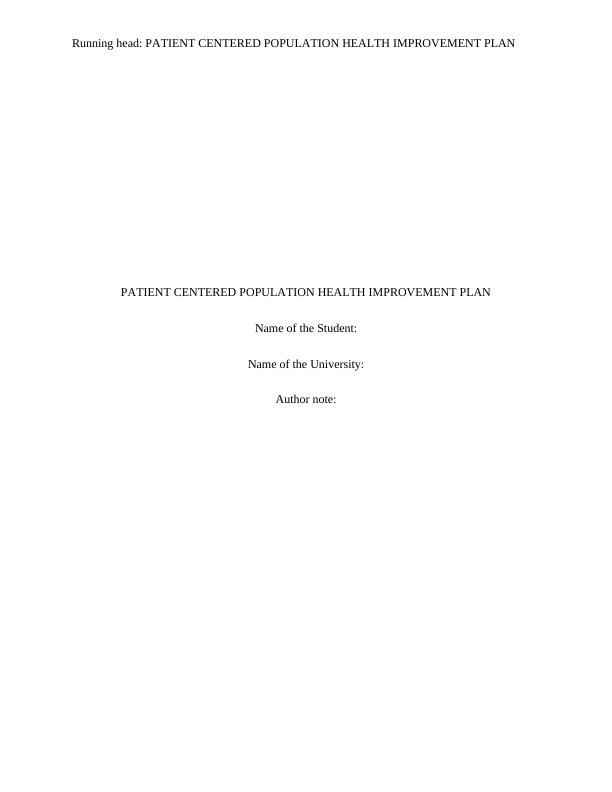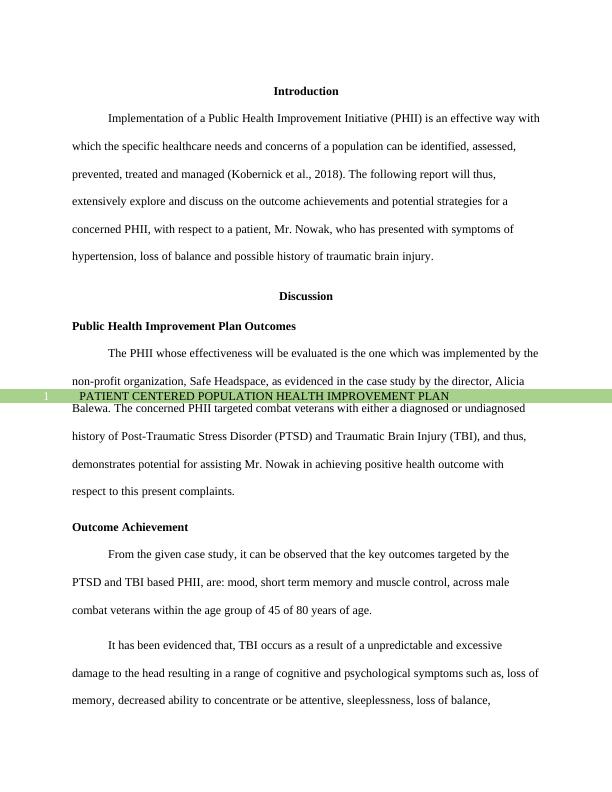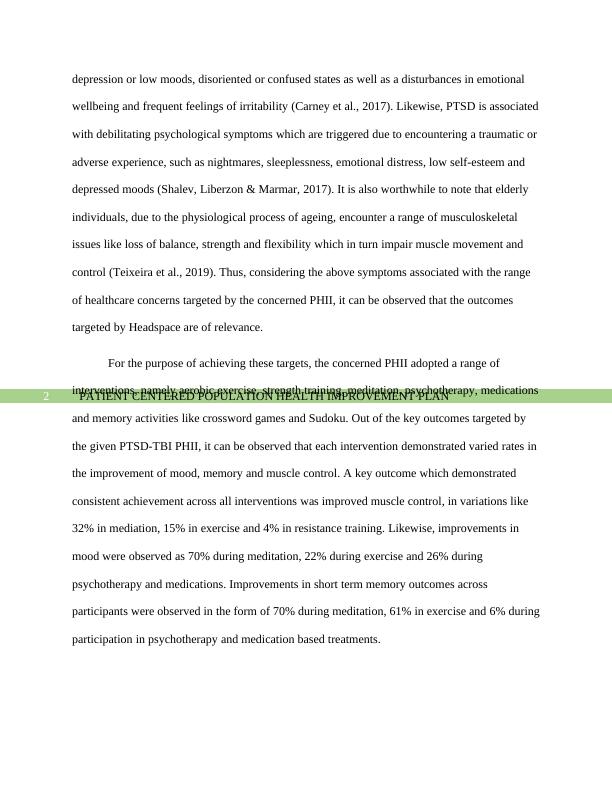Medical Journal of Islamic World
What were the outcomes of the PHII? How could they have been improved? How do the results of the PHII relate to Mr. Nowak's case?
11 Pages3065 Words19 Views
Added on 2022-08-19
Medical Journal of Islamic World
What were the outcomes of the PHII? How could they have been improved? How do the results of the PHII relate to Mr. Nowak's case?
Added on 2022-08-19
ShareRelated Documents
Running head: PATIENT CENTERED POPULATION HEALTH IMPROVEMENT PLAN
PATIENT CENTERED POPULATION HEALTH IMPROVEMENT PLAN
Name of the Student:
Name of the University:
Author note:
PATIENT CENTERED POPULATION HEALTH IMPROVEMENT PLAN
Name of the Student:
Name of the University:
Author note:

PATIENT CENTERED POPULATION HEALTH IMPROVEMENT PLAN1
Introduction
Implementation of a Public Health Improvement Initiative (PHII) is an effective way with
which the specific healthcare needs and concerns of a population can be identified, assessed,
prevented, treated and managed (Kobernick et al., 2018). The following report will thus,
extensively explore and discuss on the outcome achievements and potential strategies for a
concerned PHII, with respect to a patient, Mr. Nowak, who has presented with symptoms of
hypertension, loss of balance and possible history of traumatic brain injury.
Discussion
Public Health Improvement Plan Outcomes
The PHII whose effectiveness will be evaluated is the one which was implemented by the
non-profit organization, Safe Headspace, as evidenced in the case study by the director, Alicia
Balewa. The concerned PHII targeted combat veterans with either a diagnosed or undiagnosed
history of Post-Traumatic Stress Disorder (PTSD) and Traumatic Brain Injury (TBI), and thus,
demonstrates potential for assisting Mr. Nowak in achieving positive health outcome with
respect to this present complaints.
Outcome Achievement
From the given case study, it can be observed that the key outcomes targeted by the
PTSD and TBI based PHII, are: mood, short term memory and muscle control, across male
combat veterans within the age group of 45 of 80 years of age.
It has been evidenced that, TBI occurs as a result of a unpredictable and excessive
damage to the head resulting in a range of cognitive and psychological symptoms such as, loss of
memory, decreased ability to concentrate or be attentive, sleeplessness, loss of balance,
Introduction
Implementation of a Public Health Improvement Initiative (PHII) is an effective way with
which the specific healthcare needs and concerns of a population can be identified, assessed,
prevented, treated and managed (Kobernick et al., 2018). The following report will thus,
extensively explore and discuss on the outcome achievements and potential strategies for a
concerned PHII, with respect to a patient, Mr. Nowak, who has presented with symptoms of
hypertension, loss of balance and possible history of traumatic brain injury.
Discussion
Public Health Improvement Plan Outcomes
The PHII whose effectiveness will be evaluated is the one which was implemented by the
non-profit organization, Safe Headspace, as evidenced in the case study by the director, Alicia
Balewa. The concerned PHII targeted combat veterans with either a diagnosed or undiagnosed
history of Post-Traumatic Stress Disorder (PTSD) and Traumatic Brain Injury (TBI), and thus,
demonstrates potential for assisting Mr. Nowak in achieving positive health outcome with
respect to this present complaints.
Outcome Achievement
From the given case study, it can be observed that the key outcomes targeted by the
PTSD and TBI based PHII, are: mood, short term memory and muscle control, across male
combat veterans within the age group of 45 of 80 years of age.
It has been evidenced that, TBI occurs as a result of a unpredictable and excessive
damage to the head resulting in a range of cognitive and psychological symptoms such as, loss of
memory, decreased ability to concentrate or be attentive, sleeplessness, loss of balance,

PATIENT CENTERED POPULATION HEALTH IMPROVEMENT PLAN2
depression or low moods, disoriented or confused states as well as a disturbances in emotional
wellbeing and frequent feelings of irritability (Carney et al., 2017). Likewise, PTSD is associated
with debilitating psychological symptoms which are triggered due to encountering a traumatic or
adverse experience, such as nightmares, sleeplessness, emotional distress, low self-esteem and
depressed moods (Shalev, Liberzon & Marmar, 2017). It is also worthwhile to note that elderly
individuals, due to the physiological process of ageing, encounter a range of musculoskeletal
issues like loss of balance, strength and flexibility which in turn impair muscle movement and
control (Teixeira et al., 2019). Thus, considering the above symptoms associated with the range
of healthcare concerns targeted by the concerned PHII, it can be observed that the outcomes
targeted by Headspace are of relevance.
For the purpose of achieving these targets, the concerned PHII adopted a range of
interventions, namely aerobic exercise, strength training, meditation, psychotherapy, medications
and memory activities like crossword games and Sudoku. Out of the key outcomes targeted by
the given PTSD-TBI PHII, it can be observed that each intervention demonstrated varied rates in
the improvement of mood, memory and muscle control. A key outcome which demonstrated
consistent achievement across all interventions was improved muscle control, in variations like
32% in mediation, 15% in exercise and 4% in resistance training. Likewise, improvements in
mood were observed as 70% during meditation, 22% during exercise and 26% during
psychotherapy and medications. Improvements in short term memory outcomes across
participants were observed in the form of 70% during meditation, 61% in exercise and 6% during
participation in psychotherapy and medication based treatments.
depression or low moods, disoriented or confused states as well as a disturbances in emotional
wellbeing and frequent feelings of irritability (Carney et al., 2017). Likewise, PTSD is associated
with debilitating psychological symptoms which are triggered due to encountering a traumatic or
adverse experience, such as nightmares, sleeplessness, emotional distress, low self-esteem and
depressed moods (Shalev, Liberzon & Marmar, 2017). It is also worthwhile to note that elderly
individuals, due to the physiological process of ageing, encounter a range of musculoskeletal
issues like loss of balance, strength and flexibility which in turn impair muscle movement and
control (Teixeira et al., 2019). Thus, considering the above symptoms associated with the range
of healthcare concerns targeted by the concerned PHII, it can be observed that the outcomes
targeted by Headspace are of relevance.
For the purpose of achieving these targets, the concerned PHII adopted a range of
interventions, namely aerobic exercise, strength training, meditation, psychotherapy, medications
and memory activities like crossword games and Sudoku. Out of the key outcomes targeted by
the given PTSD-TBI PHII, it can be observed that each intervention demonstrated varied rates in
the improvement of mood, memory and muscle control. A key outcome which demonstrated
consistent achievement across all interventions was improved muscle control, in variations like
32% in mediation, 15% in exercise and 4% in resistance training. Likewise, improvements in
mood were observed as 70% during meditation, 22% during exercise and 26% during
psychotherapy and medications. Improvements in short term memory outcomes across
participants were observed in the form of 70% during meditation, 61% in exercise and 6% during
participation in psychotherapy and medication based treatments.

PATIENT CENTERED POPULATION HEALTH IMPROVEMENT PLAN3
Contributing Factors
From the above results, it can be observed that for each intervention implemented by the
given PHII for PTSD and TBI, variations were reported in terms outcome achievements. While
the success of a PHII is largely dependent on the quality and frequency of interventions, there is
also a need to address social determinants of health such as an individual’s literacy levels, culture
and personal behaviors for the purpose of ensuring optimum patient compliance and participation
(Hill et al., 2017).
Prior to in any form PHII intervention, program, there is a need to educate participants on
the nature and consequences of their health concerns and the range of best practice interventions
which can be used to manage the same. Often participants demonstrate low compliance to PHII
programs due to inadequate health literacy and lack of awareness concerning the benefits
associated with participation (Barton et al., 2018). Indeed, it can be observed that Headspace, did
not attempt to educate participants on the outcomes associated with each intervention, which
may be a reason why participants were not aware of the advantages in meditations and thus
demonstrated low rates of engagement. Additionally, as per the trans-theoretical model,
individuals are most likely to demonstrate resistance to health behavior change. To address the
same, program formulates must not only educate participants but must also obtain feedback from
them in order to understand any grievances (Hashemzadeh et al., 2019). Lack of the same is
likely to pave the way for participant dissatisfaction and attrition – as evidenced in the high rates
of exercise program dropouts, possibly due to age-associated inability to engage strenuous
activities (Tseng et al., 2017). Lastly, it can be observed that despite incorporating psychological
assessments, Headspace did not seem to prioritize comprehensive health assessments and
structure their interventions based on results of the same. Comprehensive health assessments
Contributing Factors
From the above results, it can be observed that for each intervention implemented by the
given PHII for PTSD and TBI, variations were reported in terms outcome achievements. While
the success of a PHII is largely dependent on the quality and frequency of interventions, there is
also a need to address social determinants of health such as an individual’s literacy levels, culture
and personal behaviors for the purpose of ensuring optimum patient compliance and participation
(Hill et al., 2017).
Prior to in any form PHII intervention, program, there is a need to educate participants on
the nature and consequences of their health concerns and the range of best practice interventions
which can be used to manage the same. Often participants demonstrate low compliance to PHII
programs due to inadequate health literacy and lack of awareness concerning the benefits
associated with participation (Barton et al., 2018). Indeed, it can be observed that Headspace, did
not attempt to educate participants on the outcomes associated with each intervention, which
may be a reason why participants were not aware of the advantages in meditations and thus
demonstrated low rates of engagement. Additionally, as per the trans-theoretical model,
individuals are most likely to demonstrate resistance to health behavior change. To address the
same, program formulates must not only educate participants but must also obtain feedback from
them in order to understand any grievances (Hashemzadeh et al., 2019). Lack of the same is
likely to pave the way for participant dissatisfaction and attrition – as evidenced in the high rates
of exercise program dropouts, possibly due to age-associated inability to engage strenuous
activities (Tseng et al., 2017). Lastly, it can be observed that despite incorporating psychological
assessments, Headspace did not seem to prioritize comprehensive health assessments and
structure their interventions based on results of the same. Comprehensive health assessments

End of preview
Want to access all the pages? Upload your documents or become a member.
